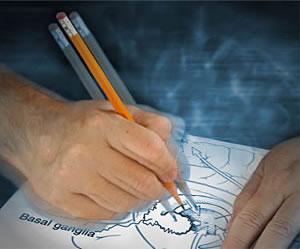ABOUT THE DISEASE
"Movement Disorders" is a subspecialty of Neurology. Movement disorders are neurological conditions that affect the speed, fluency, quality and ease of an individual movement.
SYMPTOMS
Movement Disorders are further sub divided into abnormally decreased motor functions (hypopkinetic) and abnormally increased motor functions (hyperkinetic) disorders.
1. Hypokinetic Disorders:-
a. Parkinson`s disease
b. Parkinsonism Plus Syndromes
c. Secondary Parkinsonism Syndromes
2. Hyperkinetic Disorders:-
a. Tremors
b. Dystonia
c. Chorea
d. Tics
e. Myoclonus

Features of Various Movement Disorders:
A. Parkinson`s Disease:
It is characterized by progressive slowness, stiffness and tremoulousness. It is an easily treatable disorder with almost near normal quality of life.
The symptoms of Parkinson`s disease are varied and are broadly classified into motor and non-motor symptoms. The motor symptoms include Slowness, Shaking (Tremors), Tightness (Rigidity), Falls/balance issues and speech /swallowing problems. The non-motor symptoms include Neuropsychiatric issues, Sleep disorders, Autonomic symptoms, gastrointestinal symptoms, Sensory symptoms and various other features.
B. Parkinsonism Plus Syndromes:
Even though most of the hypokinetic disorders are typically Parkinson`s disease, there are small percentage of degenerative diseases which do have features of Parkinson`s disease (namely, tremors, stiffness, slowness, balance issue), but are different in their clinical features, outcome and pathological changes and hence these are called as Parkinsonism plus syndromes. Some of these include Multiple system atrophy (commonly known as MSA), progressive supranuclear palsy, corticobasal syndrome and others.
C. Secondary Parkinsonism Syndromes:
Secondary Parkinsonism syndromes are a group of diseases which are clinically similar to Parkinson`s disease like symptoms but are caused by various other causes like stroke, brain infection, brain trauma, drug effects, and metabolic causes.
D. Tremors:
Tremors are rhythmic shaking of a body part caused by muscle contraction and are most commonly, hereditary and physiological. Tremors can be seen only at rest (as in Parkinson`s disease) or can be predominantly seen during various actions. When tremors are present during action they may affect various activities like writing, feeding and personal hygiene. In extreme cases, they make a patient almost dependent for every activity of daily living.
E. Dystonia:
Dystonia is an abnormal involuntary muscle contraction, which forces body parts to abnormal postures (sometimes painful). It is thought to occur due to disorganization in certain areas of brain (e.g., Basal ganglia) that is responsible for normal body movements. In this disorder, abnormal signals are sent from the brain to the muscles, which cause simultaneous contractions of several muscles. When this happens it leads to abnormal and sometimes painful posturing of body parts. Dystonia can present itself in various ways. Based upon the body part affected they are defined into various types. These include Cervical dystonia (Dystonia of the neck), Blepharospasm (Increased blinking of the eyes), Hemifacial spasm (contraction of one side of the face), writers cramp (abnormal contraction of hand while writing), hemidystonia, Generalized dystonia, oromandibular dystonia and dystonic tremors to name a few.
Most common cause of dystonia is Idiopathic or Genetic reasons. However it is also caused by Stroke, brain infection, brain trauma, poisoning, hypoxia, jaundice, and side effects of various drugs.
Dystonia affects one`s life from almost no problems to significant disabilities. It can limit person`s social life by social embarrassment, anxiety, depression or can cause `functional vision loss` due to excessive eye blinking, can affect driving abilities or could affect specific tasks (like writing) or all activities of daily living which include, eating, hygiene, speaking, swallowing, and walking /balance. Pain also affects day-to-day works and hence reducing work output.
F. Chorea:
Chorea is characterized by irregular, non-sustained muscle contractions. They appear as if person is making free dance like movements. It is caused by various disorders, but mostly commonly recognized in India is due to its association with Rheumatic heart disease, which is common in young age population. The other most easily recognized disorder is Huntington`s disease, which runs in family and most commonly seen in adults.
G. Other Hyperkinetic Disorders:
In addition to above commonly recognized hyperkinetic disorders, there are various other hyperkinetic disorders which can be described based upon the movement characteristics. Most of these disorders are caused by various etiologies and can be managed by drug therapies.
- • Tics: Involuntary abrupt jerk like movements which are voluntary.
- • Myoclonus: Sudden, involuntary and brief jerky movements of the body or specific body parts.
- • Stereotypy: Repetitive purposeless movements.
- • Restless legs syndrome: Intense desire to move the legs often associated with uncomfortable sensations in legs especially in evenings/night.
- • Ataxia: Inco-ordination of limbs (drunkard like)
CAUSES
Movement disorders can result from the following:
- Age-related changes
- Environmental toxins
- Genetic disorders (e.g. Huntington`s disease, Wilson disease)
- Medications (e.g. antipsychotic drugs)
- Metabolic disorders (e.g. hyperthyroidism)
- Parkinson`s disease
- Stroke
DIAGNOSIS
- Medical history
- Physical / neurological examination
- Blood tests
- Imaging tests (CT/MRI/PET)
- EMG
- EEG
TREATMENT METHODS
Treatment for movement disorders depends on the underlying cause. In most cases, the goal of treatment is to relieve symptoms. Treatment may include medication, botulinum toxin injection therapy (Botox therapy), and surgery.
Contributed by:
Dr. Prashanth LK
DM (Neurology) Fellowship in Movement Disorders (Toronto))
Consultant Neurologist.
Specialist : Parkinson`s Disease & Other Movement Disorders
You may also like to learn about:
Parkinson disease
Epilepsy
Tremor
Dystonia
Bells palsy
Neuralgia